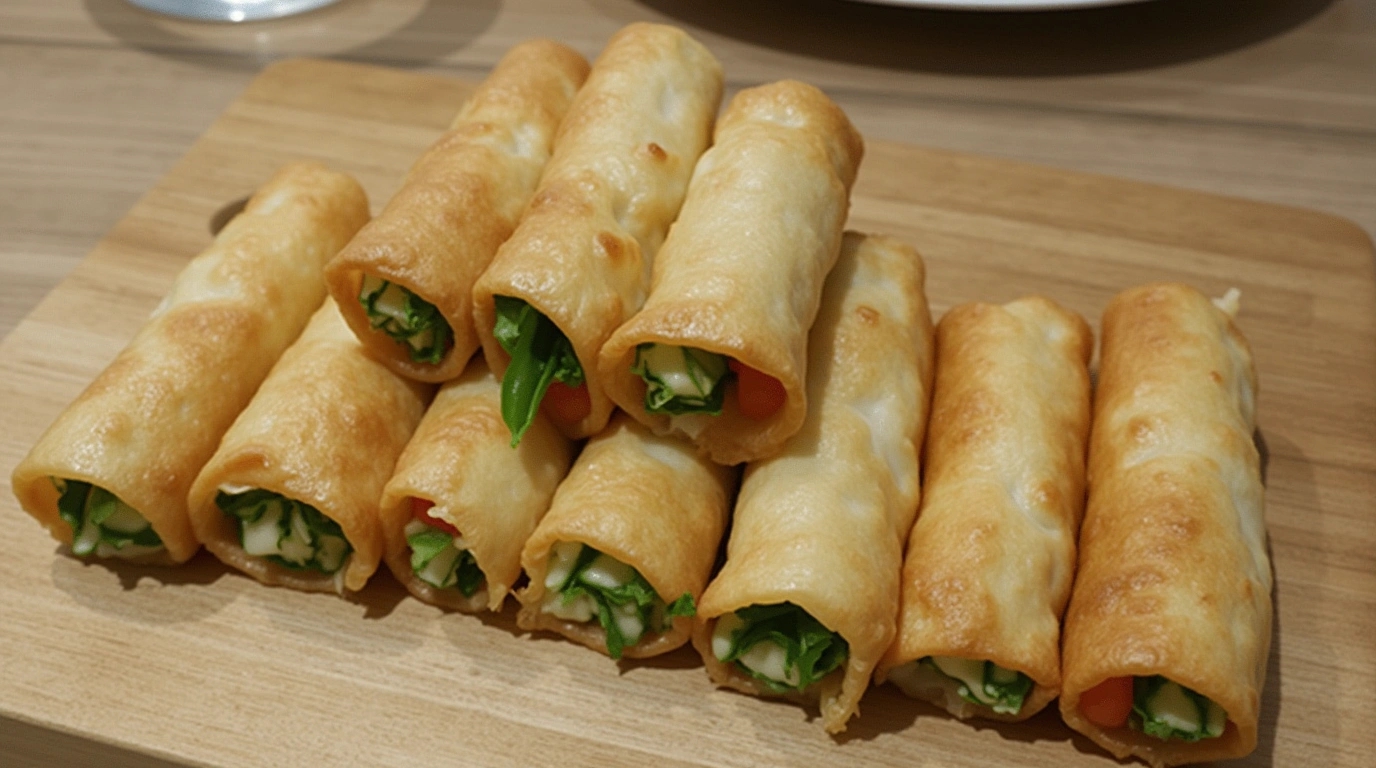Introduction: The Magic of Homemade Spring Rolls
Growing up, spring rolls were always that special treat that seemed impossible to recreate at home. I remember watching my grandmother’s hands work with lightning speed, effortlessly wrapping perfect rolls while I struggled with torn wrappers and filling spilling everywhere. For years, I believed spring rolls were best left to the experts—until I discovered these foolproof methods that changed everything.
There’s something deeply satisfying about biting into a spring roll you’ve made yourself. That perfect crunch of a fried wrapper or the fresh snap of vegetables tucked into translucent rice paper. Yet so many home cooks shy away from attempting them, convinced they require professional skills or specialized equipment.
Let me assure you—that simply isn’t true. With the right guidance, anyone can master the art of spring roll creation. Today, I’m sharing seven approachable spring roll recipes that will transform you from hesitant beginner to confident creator. These methods have been tested and refined specifically for home kitchens, with ingredients you can find at most grocery stores.
Whether you’re craving the fresh brightness of Vietnamese-style rolls or the satisfying crunch of fried classics, these recipes will give you the foundation to experiment with confidence. Let’s begin your spring roll journey—no culinary degree required.
Understanding Spring Roll Basics
Fresh vs. Fried Spring Rolls
Spring rolls come in numerous varieties across Asian cuisines, but most fall into two main categories: fresh and fried. Fresh spring rolls (sometimes called summer rolls, particularly in Vietnamese cuisine) use uncooked rice paper wrappers that become pliable when briefly soaked in water. These translucent wrappers envelope raw vegetables, herbs, and sometimes pre-cooked proteins, resulting in a light, refreshing appetizer or light meal.
Fried spring rolls, by contrast, use wheat-based wrappers that crisp up beautifully when exposed to hot oil. These wrappers seal in a pre-cooked filling, creating that irresistible crunch we associate with traditional appetizers.
- Bist Amazon Picks:
The health benefits between these varieties differ significantly. Fresh spring rolls typically contain fewer calories and less fat, making them an excellent choice for health-conscious diners. Fried versions deliver that satisfying crunch and deeper flavor profile that many find irresistible as an occasional indulgence.
Essential Ingredients for Perfect Spring Rolls
Creating restaurant-quality spring rolls at home begins with selecting the right ingredients:
- Wrappers: Rice paper rounds (for fresh rolls) or spring roll wrappers (for fried versions) form your foundation. Rice paper is typically found in round sheets that become pliable when dampened. Spring roll wrappers for frying usually contain wheat flour and come in square sheets.
- Fillings: The beauty of spring rolls lies in their versatility. Traditional components include shredded vegetables (carrots, cucumber, bell peppers), fresh herbs (mint, cilantro, basil), proteins (shrimp, pork, tofu), and sometimes rice vermicelli noodles.
- Dipping Sauces: These provide essential flavor balance. Common options include peanut sauce, sweet chili sauce, and nuoc cham (a Vietnamese dipping sauce with fish sauce, lime, sugar, and chili).
Tools You’ll Need (Nothing Fancy Required!)
The good news? You likely already own everything necessary to make exceptional spring rolls:
- Large bowl for soaking rice paper
- Cutting board and sharp knife for preparation
- Clean, damp kitchen towel for rolling surface
- Small bowls for organizing prepared ingredients
- Plate or tray for finished rolls
No specialized equipment required! If you’re making fried spring rolls, a large pot or deep skillet works perfectly. A candy/deep-fry thermometer helps maintain the proper temperature, but you can test the oil with a small piece of bread—it should sizzle and brown in about 60 seconds when the oil is ready.
Mastering the Spring Roll Wrap Technique
Step-by-Step Rolling Instructions
The wrapping technique makes or breaks your spring roll experience. Follow these steps for consistently beautiful results:
- Prepare all ingredients before beginning. This mise en place approach prevents rice paper from drying out while you search for components.
- For fresh rolls, quickly dip rice paper in warm water (not hot) for just 3-5 seconds. It will continue softening as you work.
- Place the wrapper on a clean, slightly damp surface. A wooden cutting board or damp kitchen towel works well.
- Position fillings slightly below the center of the wrapper, leaving at least 1.5 inches on each side.
- For optimal structure, use this layering order: lettuce first (creates a barrier against moisture), then herbs, vegetables, and protein.
- Fold the bottom edge up over the filling, then fold in the sides. Continue rolling upward while maintaining gentle tension for a tight package.
- Seal the edge by slightly moistening it if necessary.
Common mistakes include overfilling the wrapper (start with less than you think you need), soaking rice paper too long (making it unmanageably sticky), or rolling too loosely (causing the roll to fall apart).
Prep-Ahead Strategies for Easier Assembly
Transform spring roll making from tedious to effortless with these preparation strategies:
- Chop all vegetables up to a day ahead, storing them in separate airtight containers lined with slightly damp paper towels.
- Cook proteins and noodles in advance, refrigerating until needed.
- Create an assembly line by arranging all components in the order they’ll be used.
- For entertaining, consider a DIY spring roll bar where guests assemble their own creations—it’s interactive and removes last-minute preparation pressure.
Recipe #1: Classic Vietnamese Fresh Spring Rolls
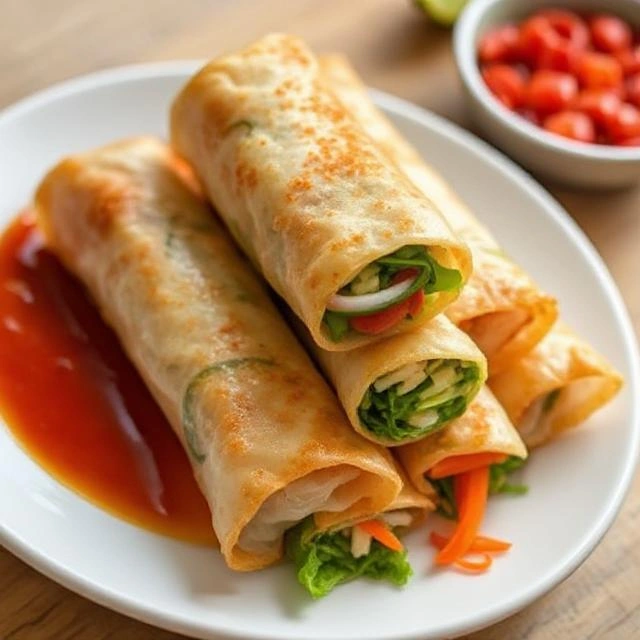
The Perfect Balance of Flavors and Textures
These fresh, translucent rolls showcase the vibrant colors and textures of their ingredients. They deliver a satisfying combination of crisp vegetables, aromatic herbs, chewy noodles, and succulent shrimp.
Ingredients
| Ingredient | Amount | Notes |
|---|---|---|
| Rice paper rounds | 12 sheets | 8.5-inch diameter |
| Cooked shrimp | 12 oz | Halved lengthwise |
| Rice vermicelli | 4 oz | Cooked and cooled |
| Butter lettuce | 12 leaves | Washed and dried |
| Fresh mint | 1 bunch | Leaves only |
| Fresh cilantro | 1 bunch | Leaves only |
| Fresh basil | 1 bunch | Thai basil preferred |
| Cucumber | 1 medium | Cut into thin strips |
| Carrots | 2 medium | Julienned |
Step-by-Step Instructions
- Cook vermicelli according to package directions, rinse under cold water, drain thoroughly, and set aside.
- Prepare all vegetables and herbs: julienne carrots and cucumber, separate herb leaves from stems, wash and thoroughly dry lettuce leaves.
- Fill a large, shallow bowl with warm water. Dip one rice paper wrapper for about 5 seconds—it should remain slightly firm as it will continue softening.
- Place the wrapper on a clean, damp kitchen towel. Position a lettuce leaf slightly below center.
- Arrange a small amount of noodles (about 2 tablespoons) atop the lettuce, followed by a few herb leaves, vegetable strips, and 2-3 shrimp halves, pink side down.
- Fold the bottom edge up over the filling, then fold in the sides. Continue rolling upward with gentle tension to create a tight cylinder.
- Place completed rolls on a plate with slight space between them to prevent sticking. Cover with a damp paper towel if not serving immediately.
Peanut Dipping Sauce Recipe
| Ingredient | Amount | Notes |
|---|---|---|
| Creamy peanut butter | 1/3 cup | Natural, unsweetened |
| Hoisin sauce | 2 tbsp | |
| Lime juice | 2 tbsp | Freshly squeezed |
| Soy sauce | 1 tbsp | Low-sodium preferred |
| Brown sugar | 1 tbsp | Adjust to taste |
| Garlic | 1 clove | Minced |
| Water | 3-4 tbsp | For consistency |
| Crushed peanuts | 2 tbsp | For garnish |
Whisk all ingredients except water and crushed peanuts until well combined. Add water gradually until you reach your desired consistency. Top with crushed peanuts before serving.
Recipe #2: Crispy Vegetable Spring Rolls

Crowd-Pleasing Appetizers in 30 Minutes
These golden-brown treasures deliver satisfying crunch and savory flavor. The vegetarian filling ensures everyone at your table can enjoy them.
Ingredients
| Ingredient | Amount | Notes |
|---|---|---|
| Spring roll wrappers | 20 sheets | Defrosted if frozen |
| Cabbage | 2 cups | Finely shredded |
| Carrots | 2 medium | Julienned |
| Mushrooms | 8 oz | Finely chopped |
| Bean sprouts | 1 cup | Fresh |
| Green onions | 4 stalks | Thinly sliced |
| Garlic | 3 cloves | Minced |
| Ginger | 1 tbsp | Freshly grated |
| Soy sauce | 2 tbsp | Low-sodium |
| Sesame oil | 1 tsp | |
| Vegetable oil | For frying |
Step-by-Step Instructions
- Heat 1 tablespoon vegetable oil in a large skillet over medium-high heat. Add garlic and ginger, cooking until fragrant (about 30 seconds).
- Add mushrooms, cooking until they release their moisture and begin to brown (3-4 minutes).
- Add cabbage, carrots, bean sprouts, and green onions. Cook, stirring frequently, until vegetables are crisp-tender (about 4 minutes).
- Stir in soy sauce and sesame oil. Remove from heat and cool completely before assembling rolls.
- Position a wrapper diamond-shaped with a corner pointing toward you. Place about 2 tablespoons of filling in a line horizontally across the lower third of the wrapper.
- Fold the bottom corner up over the filling, then fold in the sides. Roll upward, keeping tension tight. Seal the final edge with a paste made from flour and water if needed.
- Heat oil to 350°F in a deep pot. Fry spring rolls in batches for 2-3 minutes until golden brown. Drain on paper towels and serve hot.
Recipe #3: Baked Spring Rolls (Healthier Alternative)
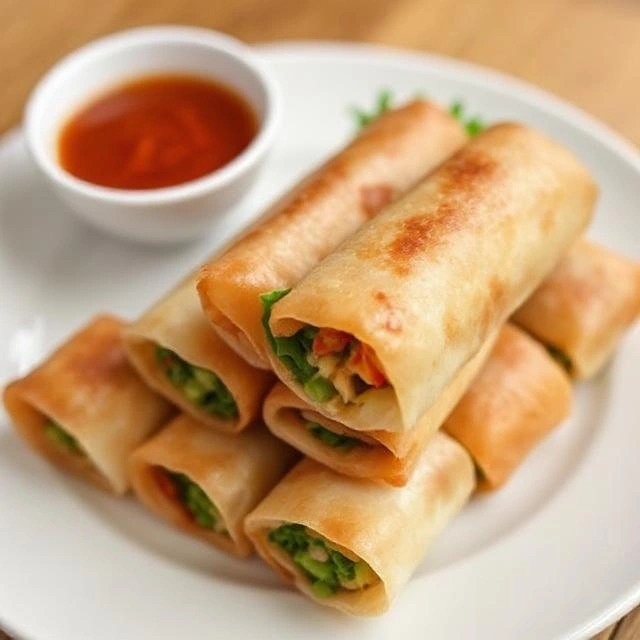
Crispy Satisfaction Without the Oil
For those seeking the crunch without deep-frying, these baked spring rolls offer a healthier alternative without sacrificing texture or flavor.
Ingredients and Nutritional Benefits
The ingredient list matches Recipe #2, but with these modifications:
- Replace frying oil with 2 tablespoons olive oil for brushing
- Add 1 egg white (lightly beaten) for sealing edges
Nutritionally, these baked versions contain approximately 65% less fat than their fried counterparts while maintaining protein, fiber, and vitamin content from the vegetable filling.
Step-by-Step Instructions
- Preheat oven to 425°F and line a baking sheet with parchment paper.
- Prepare filling as directed in Recipe #2.
- Assemble spring rolls following the same technique, using egg white to seal the edges securely.
- Arrange rolls on the baking sheet with space between them. Brush all surfaces lightly with olive oil.
- Bake for 15-18 minutes, turning halfway through, until golden brown and crisp.
- Serve immediately with dipping sauce of your choice.
Recipe #4: Gluten-Free Spring Rolls
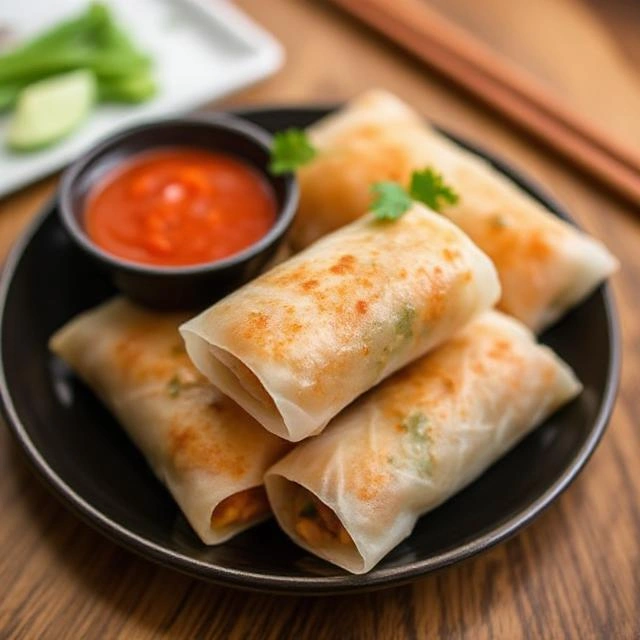
Satisfying Dietary Restrictions Without Sacrificing Flavor
These adaptations ensure everyone can enjoy spring rolls regardless of dietary needs.
Ingredients and Substitutions
For fresh spring rolls, traditional rice paper wrappers are naturally gluten-free. For fried versions, seek out these alternatives:
| Ingredient | Gluten-Free Substitute | Where to Find |
|---|---|---|
| Spring roll wrappers | Rice paper wrappers (same as fresh rolls) | Asian grocery stores, international food aisles |
| Soy sauce | Tamari or gluten-free soy sauce | Most grocery stores |
| Hoisin sauce | Gluten-free hoisin sauce | Specialty stores or online |
When preparing gluten-free spring rolls, maintain a clean workspace free from cross-contamination. Use separate cutting boards and utensils if your kitchen regularly processes gluten-containing ingredients.
Step-by-Step Instructions
For fried gluten-free spring rolls using rice paper:
- Prepare filling as in Recipe #2, substituting tamari for soy sauce.
- Use two sheets of rice paper per roll for structure. Dip each sheet very briefly in warm water.
- Layer the two slightly damp sheets together on your work surface.
- Add filling and roll as with traditional spring rolls, but with extra care as rice paper is more delicate.
- Heat oil to 360°F (slightly hotter than regular spring rolls).
- Fry for 2-3 minutes until golden and crisp. Monitor closely as these cook faster than wheat-based wrappers.
Recipe #5: Dessert Spring Rolls
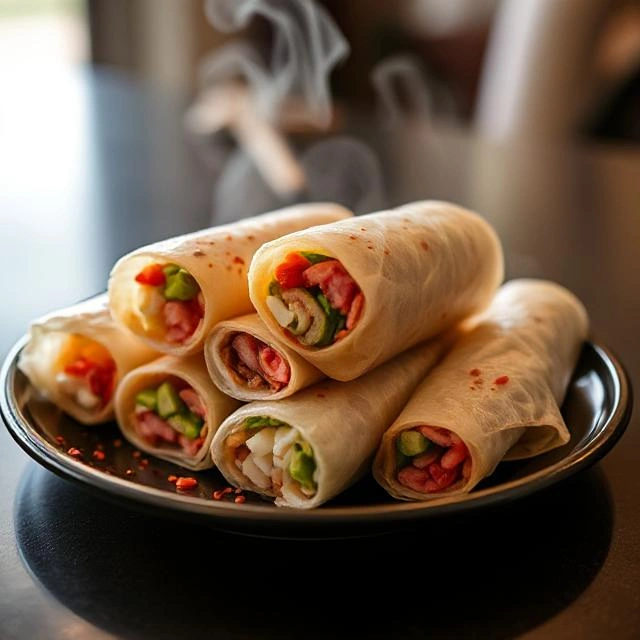
A Sweet Twist on a Savory Classic
Surprise your guests with this unexpected finale to your meal—spring rolls transform beautifully into dessert vessels.
Ingredients for Chocolate Banana Spring Rolls
| Ingredient | Amount | Notes |
|---|---|---|
| Spring roll wrappers | 8 sheets | |
| Bananas | 2 medium | Slightly firm |
| Chocolate chips | 1/2 cup | Semi-sweet |
| Brown sugar | 2 tbsp | |
| Cinnamon | 1/2 tsp | |
| Butter | 2 tbsp | Melted |
| Powdered sugar | For dusting | |
| Vanilla ice cream | For serving | Optional |
Step-by-Step Instructions
- Slice bananas into 3-inch lengths, then cut each piece in half lengthwise.
- Place a spring roll wrapper in diamond orientation. Position banana piece horizontally across the lower third.
- Sprinkle with chocolate chips (about 1 tablespoon per roll), a pinch of brown sugar, and cinnamon.
- Fold and roll as with savory spring rolls, sealing edges with water.
- For fried version: Heat oil to 350°F and fry until golden (about 2 minutes).
- For baked version: Brush with melted butter and bake at 375°F for 15-20 minutes until golden.
- Dust with powdered sugar while still warm and serve immediately, alongside vanilla ice cream if desired.
Recipe #6: Breakfast Spring Rolls
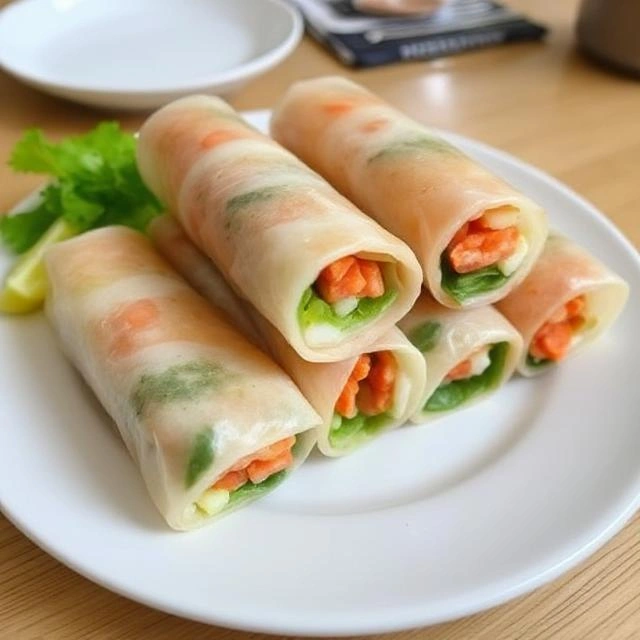
Morning Meals Made Exciting
Reinvent breakfast with these protein-packed rolls that combine familiar morning flavors in a portable package.
Ingredients for Egg and Avocado Spring Rolls
| Ingredient | Amount | Notes |
|---|---|---|
| Rice paper wrappers | 6 sheets | |
| Eggs | 3 large | Scrambled |
| Avocado | 1 medium | Sliced |
| Cherry tomatoes | 1/2 cup | Halved |
| Spinach | 1 cup | Fresh |
| Feta cheese | 1/4 cup | Crumbled |
| Salt and pepper | To taste | |
| Hot sauce | Optional | For serving |
Step-by-Step Instructions
- Scramble eggs until just set but still slightly moist. Season with salt and pepper, then cool completely.
- Prepare remaining ingredients: slice avocado, halve tomatoes, wash spinach.
- Dip rice paper briefly in warm water and place on work surface.
- Layer spinach leaves, scrambled egg (about 2 tablespoons), avocado slices, tomatoes, and a sprinkle of feta slightly below center.
- Roll according to standard technique for fresh spring rolls.
- Serve immediately with hot sauce or salsa on the side.
These can be made up to two hours ahead if wrapped individually in plastic wrap and refrigerated.
Recipe #7: Party-Size Spring Roll Platter

Impressing Guests with Minimal Effort
Create a showstopping appetizer spread with this trio of spring roll variations, perfect for entertaining.
Ingredients for Three Different Variations
| Variation | Key Ingredients | Dipping Sauce |
|---|---|---|
| Classic Shrimp | Shrimp, herbs, vermicelli | Peanut sauce |
| Spicy Chicken | Chicken, cabbage, chili | Sweet chili sauce |
| Veggie Supreme | Avocado, mango, tofu | Ginger-lime sauce |
Step-by-Step Instructions
- Prepare all fillings separately and arrange in distinct sections of your prep area.
- Create identification markers for each variation—colored toothpicks work wonderfully.
- Assemble rolls by type, keeping each variation together on serving platters.
- Arrange dipping sauces in small bowls, positioned near their corresponding rolls.
- Label each variety and sauce subtly with small cards if serving to guests unfamiliar with the differences.
This impressive spread can be assembled up to 3 hours before serving if kept covered with damp paper towels and plastic wrap in the refrigerator.
Troubleshooting Common Spring Roll Problems
Solutions for Every Spring Roll Emergency
Even experienced cooks encounter challenges with spring rolls. Here’s how to overcome them:
Problem: Torn wrappers
- Solution: For rice paper, use two overlapping sheets. For wheat wrappers, patch small tears with a bit of water and extra wrapper material.
Problem: Soggy fresh rolls
- Solution: Thoroughly drain all ingredients before rolling. Pat herbs and vegetables completely dry with paper towels.
Problem: Filling falls out during rolling
- Solution: Use less filling than you think you need and fold the sides in before completing the roll.
Problem: Rolls stick together
- Solution: Place finished rolls with space between them and avoid stacking. If necessary, separate with small pieces of parchment paper or plastic wrap.
Storing and Making Spring Rolls Ahead of Time
Meal Prep Strategies for Busy Weeknights
Proper storage techniques extend the enjoyment of your spring roll creation:
Fresh Spring Rolls:
- Best consumed within 24 hours
- Store individually wrapped in slightly damp paper towels, then plastic wrap
- Keep refrigerated until serving
Fried Spring Rolls:
- Uncooked rolls can be frozen for up to 3 months in airtight containers with parchment paper between layers
- Cook frozen rolls directly from frozen, adding 1-2 minutes to frying time
- Cooked rolls can be refrigerated for 1-2 days and reheated in a 350°F oven for 8-10 minutes to restore crispness
Make-Ahead Components:
- Prepare fillings up to 2 days ahead
- Store components separately in airtight containers
- Assemble just before serving or cooking
Conclusion: Your Spring Roll Journey Has Just Begun
Now that you’ve mastered these seven accessible spring roll recipes, you’re equipped to create beautiful, delicious rolls any time the craving strikes. Remember that practice makes perfect, and even “imperfect” spring rolls are still delicious. The joy of homemade spring rolls isn’t just in the eating—it’s in the creating, the sharing, and the satisfaction of mastering a skill that once seemed out of reach.
Don’t be afraid to experiment with your own unique combinations as you gain confidence. Perhaps you’ll create a signature spring roll that becomes requested at every gathering. Whatever direction your spring roll journey takes, you now possess the fundamental techniques to roll with confidence.
So gather your ingredients, clear your countertop, and transform yourself from spring roll admirer to spring roll creator. Your taste buds—and impressed dinner guests—will thank you.
Frequently Asked Questions About Spring Rolls
Common Questions from Beginning Spring Roll Makers
Can spring rolls be made ahead of time?
Yes, spring rolls can be prepared in advance. Fresh spring rolls can be made 2-3 hours ahead and stored under damp paper towels in the refrigerator. Fried or baked spring rolls can be prepared and frozen before cooking. For best results with fresh spring rolls, keep the filling ingredients and wrappers separate until shortly before serving.
Why do my spring rolls get soggy?
Spring rolls often become soggy due to excess moisture in the filling ingredients. To prevent this, thoroughly drain and pat dry all vegetables, noodles, and proteins before using them in your spring rolls. For fresh spring rolls, don’t oversoak the rice paper. For fried spring rolls, ensure your oil is hot enough (around 350°F) before frying.
What’s the difference between spring rolls and egg rolls?
Spring rolls typically have a thinner wrapper made from rice paper or a thin wheat flour wrapper, while egg rolls have a thicker wrapper that contains egg. Spring rolls often contain more vegetables and can be served fresh or fried, while egg rolls are almost always fried and typically contain meat along with vegetables.
Can I use lettuce instead of rice paper for spring rolls?
Yes, large lettuce leaves can be used as a low-carb, gluten-free alternative to traditional spring roll wrappers. Choose butter lettuce, romaine hearts, or cabbage leaves, depending on your preference. Keep in mind that lettuce-wrapped spring rolls won’t be as structurally sound as traditional spring rolls, but they offer a fresh, crisp alternative.
How long do spring rolls last in the refrigerator?
Fresh spring rolls are best consumed within 24 hours but can last up to 2-3 days in the refrigerator if properly stored. Wrap them individually in plastic wrap or place them in an airtight container with damp paper towels to prevent drying out. Fried spring rolls that have been cooked should be consumed within 2 days for best quality.
What are the best dipping sauces for spring rolls?
The best dipping sauces for spring rolls include peanut sauce, sweet chili sauce, nuoc cham (Vietnamese dipping sauce), hoisin sauce, and soy-ginger sauce. Each brings different flavors that complement the fresh or fried spring rolls. For a complete spring roll experience, consider offering 2-3 different sauces to your guests.
